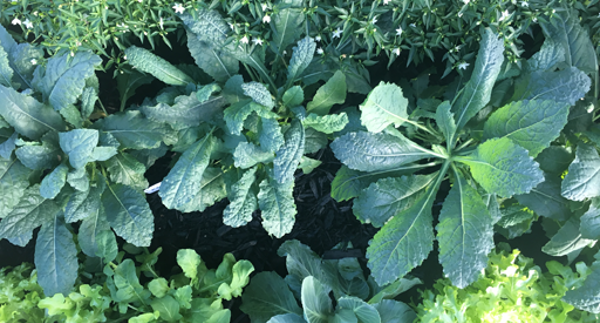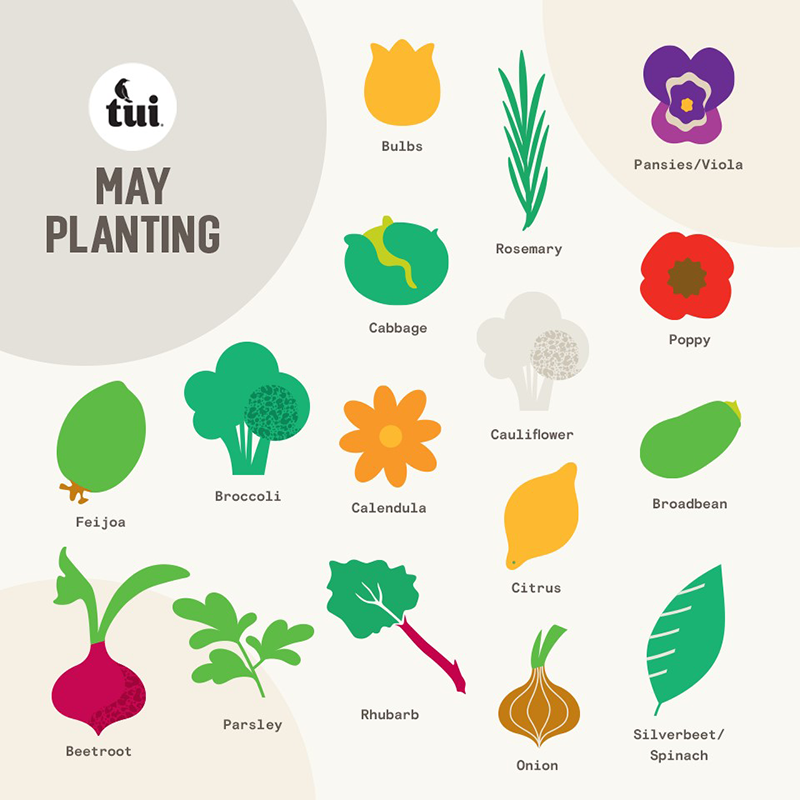
We are now in the last month of autumn and there is plenty to keep busy in the garden. In the fruit garden, the harvest period is coming to a close for pip and stone fruit and is just beginning for feijoas.
It's also the last chance to get your bulbs in the flower garden before winter, and a great time to plant new winter veges in the vege patch!
What to plant in May

In the vegetable garden
Plant
Dig in Tui Compost and Tui Organic Sheep Pellets before planting to replenish nutrients used by the heavy summer growing season.
This month you can plant the following: beetroot, bok choi, broad beans, broccoli, cabbage, cauliflower, cavolo nero, celery, coriander, garlic, kale, mesclun, onion, parsley, peas, radish, rhubarb, rocket, rosemary, sage, silverbeet, spinach, thyme.
For more veges to plant in your region, check out our Planting Calendar here
Harvest
It's time to harvest the last of your summer and autumn crops including beetroot, bok choi, broccoli, capsicums, carrots, courgettes, cucumber, kale, leeks, spring onions, sweetcorn.
Check out our recipe section for tasty recipes for your harvests.
Maintenance
- Pumpkins - pick pumpkins in areas where you want to get rid of vines, as they can take up a lot of room. Cut the stalk from the vine, leaving the handle-type stem on the pumpkin. Store somewhere dry off the ground.
- Herbs - protect tender herbs like basil from the cold to prolong the harvest - cover with frost cloth or something similar in the evenings.
- Lay Tui Quash to control slugs and snails eating your seedlings.
- Feed herbs and winter greens once a month with Tui Organic Seaweed Plant Tonic.
In the fruit garden
- Pick feijoa, quince, apple, pear, rhubarb, passionfruit.
- Harvest nuts: almond, chestnut, hazelnut and walnut.
- Plant evergreen, frost-hardy fruits such as feijoa and Chilean guava. See the Tui Feijoa Growing Guide for more information. Remember fruit requires a position in full sun. Shelter from prevailing winds is preferable.
- Start preparing strawberry beds for planting in June and July. Trim back the older leaves on existing plants and remove runners. Once removed, plant into a coir pellet or into some potting mix to grow the roots and then plant into your garden once roots are established.
- Collect and compost any rotting fruit from under fruit trees.
- Aphids, whitefly and scale insects may be about, blast off with a hose, apply warm soapy water or select a suitable spray at your garden centre.
In the flower garden
- Mother’s Day is one of the highlights of May. Giving and receiving plants and flowers is a wonderful way to acknowledge someone special.
- Last opportunity to plant spring bulbs before the soils get too cold.
- Pick Leucadendron, flowering kale, dianthus, roses, Peruvian lily, poppies, Marguerite daisy, statice, Japanese anemones, Erica.
- Apply Tui Bulb Food to bulbs already in the ground.
- Apply a side dressing of Tui NovaTec Premium fertiliser to shrub borders and flower gardens.
- For a pop of colour plant cyclamen, bellis, calendula, polyanthus, flowering kale, primula, pansies, violas, poppies, snapdragons, wildflowers, cineraria, winter roses – Hellebores, Leucadendron.
- Prune summer flowering shrubs and trees that have finished flowering.
- Save and dry seeds of summer flowers for sowing in the spring.
Add thick layers of Tui Mulch & Feed or Tui Pea Straw Mulch to garden beds and pots to conserve water, reduce weeds and add valuable nutrients back to the soil.
Post a comment
May Gardening Guide Comments
When woudl be the right time to lift my dahlia bulbs.This summer was my very first attempt at growing them and had an amazing display. this summer.I need to lift them as I have a lot of daffodil bulbs that need to go in their area. How do I store them. Would really appreciate some advice
Ellen
Hi Ellen, autumn is the best time to lift bulbs. Gently ease a fork under the bulbs and wriggle the bulbs out of the soil. Remove all the soil from the bulbs, and cull out any that are soft or rotten and store in a cool, dry place away from direct sunlight and protected from mice. Bulbs store really well in mesh sacks. When ready, re plant into Tui Bulb Mix back into the soil with an addition of Tui Bulb Food. Thanks, Tui Team.
jenna
Hi Tui, our Dahlia's still have flowers on them, do we chop them down before lifting the corms - or wait for them to go naturally and then lift them? Thanks!
Elisabeth
Hi Elisabeth, wait for them to naturally die down, do not cut the foliage as this is the bulbs (corms) food source for the following season. They can be dug with the foliage still attached to the corms, leave the plants with foliage intact to die down naturally before removing the corms, somewhere cool and dry is ideal.
Tui Team
I thank you for your monthly catch email about what to plant and do each month it helps me out a lot Cheers Dawn Burrell
Dawn Burrell
Hi Dawn, you're welcome. Thank you for your feedback. Enjoy autumn in the garden, Tui Team
jenna
If I planted a small Fejoa now how long would it take to fruit,we face south in Onehunga Auckland?
Barbara
Hi Barbara, feijoas take 2-3 years to fruit. There are self-fertile varieties available, however all feijoas will produce heavier and more regular crops if pollinated by other fejioa varieties. Read more in our Feijoa Guide here: http://www.tuigarden.co.nz/howtoguide/feijoa-growing-guide ^Tui Team
jenna
Hi Tui, we are looking for a part time gardener to work three days/ part days each week. One of these days involves working with our senior students in our vegetable garden supported by awesome volunteers. We are hoping someone might read this and be interested is some paid part time work in a school.
Yendarra School
Very informative. Thanks.
Ezra Hunter
Is there a correct way to position garlic when planting or do roots sprout either end whichever is pointing downwards?
Michele
Hi Michele, plant garlic corms with the pointy end up. The roots form from the wider base of the corm, the shoots from the pointy end. Separate the corms from the bulb, they don't need to have the paper skin removed, pop them in the ground on the shortest day, and harvest on the longest day of the year.
Lianne, Tui Team.
Very helpful, thank you :)
Michele
Great tips for the garden, thanks.
Sheila Walsh
Hi, I want to have lemons all year round, what varieties are the best to plant in the Waikato. Thanks.
Jane Prescott
Hi Jane, the best lemon to grow for year round fruiting is a Meyer Lemon. Citrus are a sub-tropical fruit so will need protecting from severe frost, but once established, will tolerate moderate frosts. Place the tree in a sunny position in a free draining soil, heat helps initiate flowering and ultimately fruiting. Consider planting multiple trees to ensure a continuous supply of fruit.
Lianne, Tui Team.
Hi, I have lots of self seeded tomato plants and sadly no greenhouse, what is the next best solution to looking after these seedlings over winter? I do have shelfs in a window in the garage, would it be best to lift and let them carry on inside, or leave outside?
Maureen McGinnity
Hi Maureen, you could try keeping the seedlings inside and nurturing them through winter on a sunny window sill, my experience with growing tomato seedling in winter is that they are likely to die off if they aren’t in a glasshouse. The other thing about tomatoes is that it depends upon the variety. Tomatoes are either indeterminant and keep growing, flowering and fruiting as long as temperatures are warm or until the plant exhausts itself, most cherry tomatoes are indeterminant. Or they could be determinant where they grow, flower and fruit and then die down, such as Roma acid free tomatoes. Worth a try if you have the space for them inside.
Lianne
I plant winter annuals on top of the bulbs in pots and add new mix. Makes the pot area look good.
Marianne Marshall
Hi Marianne, thanks for the great tip, pansies and violas are a great addition to bulbs in pots to add colour while waiting for the spring bulbs to emerge.
Lianne